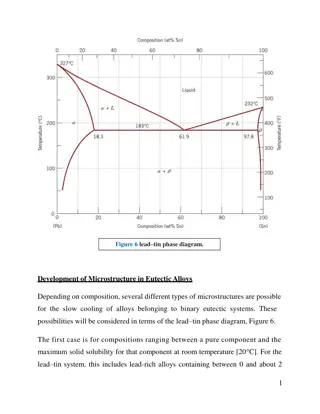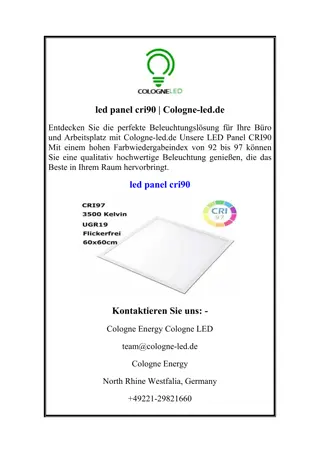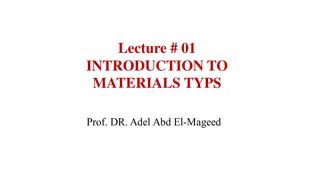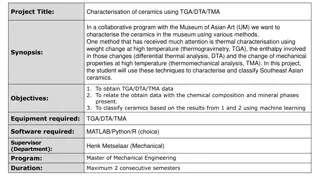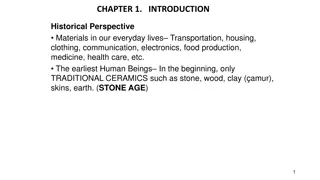MIT 3.022 Microstructural Evolution in Materials
Microstructural evolution in materials plays a crucial role in understanding heat capacity. Explore the modeling of molar heat capacity for different materials and gases, considering factors like degrees of freedom and particle interactions. Learn about partition functions, energy levels, and the impact on system energy in various systems, from monatomic to diatomic gases. Dive into the behavior of non-interacting distinguishable and indistinguishable particles, and understand how these concepts contribute to the overall heat capacity of a system.
Download Presentation

Please find below an Image/Link to download the presentation.
The content on the website is provided AS IS for your information and personal use only. It may not be sold, licensed, or shared on other websites without obtaining consent from the author.If you encounter any issues during the download, it is possible that the publisher has removed the file from their server.
You are allowed to download the files provided on this website for personal or commercial use, subject to the condition that they are used lawfully. All files are the property of their respective owners.
The content on the website is provided AS IS for your information and personal use only. It may not be sold, licensed, or shared on other websites without obtaining consent from the author.
E N D
Presentation Transcript
MIT 3.022 Microstructural Evolution in Materials 4: Heat capacity Juejun (JJ) Hu hujuejun@mit.edu
Molar heat capacity cv(J/mol K) 12.5 12.5 12.5 20.2 20.2 19.9 Degrees of freedom Material cv/R Type He Ne Ar H2 O2 N2 H2S CO2 1.5 1.5 1.5 2.43 2.43 2.39 Monatomic gas 3 translational Total 3 3 translational 2 rotational Total 5 Diatomic gas Gas 26.7 28.5 28.0 24.6 6.1 25.2 24.5 24.9 28.0 75.3 229 3.22 3.43 3.37 2.96 0.74 3.03 2.95 3.00 3.36 9.06 27.6 Depends on molecular geometry Triatomic gas H2O (100 C) Arsenic Diamond Antimony Copper Silver Mercury H2O Gasoline Non- metal 3 translational 3 vibrational Total 6 Atomic solid Metal Liquid ? Liquid The values are quoted for 25 C and 1 atm pressure for gases unless otherwise noted
Molar heat capacity modeling Molar heat capacity: N N E T = ~ c c A for condensed matter V P V Deriving heat capacity: Determine system energy levels Derive partition function Z Calculate mean energy as a function of temperature Unregistered user at uncyclopedia.wikia.com; CC-BY-SA-NC 3.0 Calculate heat capacity by taking derivative with respect to T This mole has a large molar heat capacity
Non-interacting, distinguishable particles Consider a system consisting of N identical but distinguishable particles Classical ideal gas The system s partition function is the product of individual particle s partition function = E E sys par N ( ) = = = N exp exp Z E E Z , , sys par j par j par j N j N
Non-interacting, indistinguishable particles Consider a system consisting of N indistinguishable particles Quantum ideal gas (with wave function overlap) Permutation does not generate new states The system s partition function = E E sys par N 1 N The N! factor avoids over counting of microscopic states due to permutation = N Z Z sys par !
Monatomic gas Only consider translational degrees of freedom Particle in a box model: 2 n L 2 2 2 n L n L h y = + + = + + x E E E E z par x y z 2 2 2 8 m x y z Particle partition function for translational motion along the x-direction = = 2 2 2 2 n n h h ~ exp exp x x Z dn , par x x 2 2 8 8 m L m L n x x 0 x 1 2 2 L h m x
Monatomic gas (contd) Particle partition function for translational motion L L L Z Z Z Z = = 3 2 3 2 2 2 m V h m x y z = , , , par par x par y par z 3 3 h Partition function of the system consisting of N ideal gas particles N V m Z N h 3 2 1 2 = sys 3 ! Average energy of the system ln sys Z E 3 2 Distinguishability does not affect average energy = = NkT
Monatomic gas (contd) Molar heat capacity at constant volume = = 3 2 3 2 N N E T = = 12.5 J/mol K c N k R A V A V 1 2kT Each translational degree of freedom contributes average energy (energy equipartition) Molar heat capacity cv(J/mol K) 12.5 12.5 12.5 Material cv/R He Ne Ar 1.5 1.5 1.5
Heat capacity of an atomic solid Harmonic oscillator model Each atom oscillates in its own potential well independent of other atoms Energy Potential function 1 2 ( ) o x ( ) x ( ) 0 = + + 2 2 Kx Spring constant 2 = K 2 x = x 0 x Oscillator angular frequency B C A = K m
Heat capacity of a harmonic oscillator Energy: = n E Neglect zero point energy i i Partition function: = 1 ( ) = exp Z n ( ) i 1 exp = 0 n i Mean energy: = ln Z = E ( ) exp 1 Heat capacity: ( ) exp E T ( ) 2 = = C k V ( ) 2 exp 1 V
Heat capacity of a harmonic oscillator High T limit kT C k V Low T limit ( ( kT ) 2 k ~ 0 C ) V exp
Heat capacity of a 3-D atomic solid Partition function: 3 N 1 Distinguishable atoms oscillating along x, y, and z directions = = 3 N Z Z ( ) sys 1 exp Mean energy: ln Z 3 ln 3 N Z N sys = = = E ( ) sys exp 1 Heat capacity: ( ) E exp ( ) 2 sys T = = 3 V sys C Nk , ( ) 2 exp 1 V 0 V sys c 3 V sys c R (Dulong-Petit law) High T limit Low T limit , ,
Normal modes (lattice waves) Lattice waves can be decomposed to different normal modes: Fourier analysis Normal modes of lattice wave: in analogy to particle-in-a-box
Everything you need to know about heat capacity Partition function of systems composed of distinguishable and indistinguishable particles Distinguishability does not affect average energy and heat capacity; however, it changes entropy and Z Heat capacity of monatomic gas: energy equipartition Heat capacity of harmonic oscillators Heat capacity of atomic solids: the Einstein model
List of symbols T temperature k Boltzmann constant (1.38 10-23m2kg s-2K-1) R Ideal gas constant (8.314 J mol-1 K-1) defined as = 1/kT cV / cP molar heat capacity at constant volume / pressure CV heat capacity of a system (e.g. an oscillator) average energy of a system N Total number of particles in a system NA Avogadro constant E
List of symbols Zpar / Zsys (canonical) partition function of an individual particle / a system consisting of N particles Epar / Esys energy of an individual particle / a system consisting of N particles n quantum number (subscript x, y, or z denotes the direction) L linear dimension of the system (subscript x, y, or z denotes the direction) h Planck constant (6.626 10 34 J s) reduced Planck constant (1.056 10 34 J s) m mass of particle
List of symbols (x) potential function of a harmonic oscillator K spring constant of a harmonic oscillator angular frequency of a harmonic oscillator










